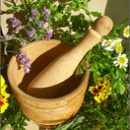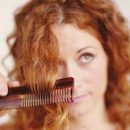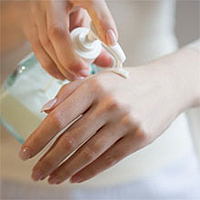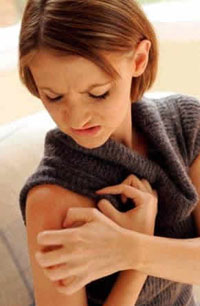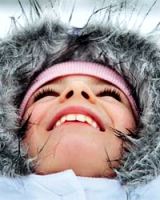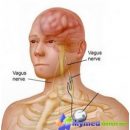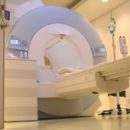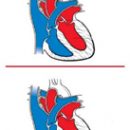What is Potna? How to prevent the child's development in a child? Swimming, air baths, how to wear a child? Answers to these questions you will find in the article.
Content
Baby skin has a number of features compared to adult leather. Firstly, it is much thinner and due to this gentle, hoping. Children's skin contains more water (up to 85% compared with 65% in adults). Breast children are much larger than adult skin blood vessels, due to which the respiratory function is intensively. But on the other hand, due to rich blood supply to the skin, in infants, many skin infectious processes are extremely quickly distributed and progress. Poto and sebaceous glands in kids are poorly developed, therefore the thermoregulation function of the skin in children of the first year of life is still imperfect: they are easily overheated and hypochea. Pigment of the skin - Melanin in infants is practically not synthesized, as a result of which the kids are defenseless before the action of ultraviolet rays.
What is Potna
As a result of the characteristics of the structure and significant functional load, the skin of the kids is very vulnerable to the development of various pathological processes. One of the most frequent problems encountered in the first year of life is the Pepper, T.E. The appearance on the skin raishes in response to overheating.
The Padman is manifested by red shallow rash, sometimes in the form of small bubbles filled with transparent content. More often, the rash is developing on the neck, her shoulders, the back of the baby, in natural folds - inguinal, in the crotch area and in the armpits. Sometimes a child can disturb heavy itching, in other cases the overall condition of the crumbs is usually not broken.
The reasons for the development of the Pattern
Typically, the development of the travelers is provoked by overheating associated either with excessive bustling of the baby, or with an elevated temperature or the environment, or at the kid itself. When overheating, the sweeping is reinforced, and underdeveloped ducts and mouths (outputs to the surface) of sweat glands do not cope with high load and sweat selection. In addition, excessive moisture contributes to the lunch of the surface layer of the skin, ultimately causing the blockage of swelling glands. This leads to the formation of those most bubbles with transparent fluid when. In addition, the minor blood vessels expanded during overheating provide redness of the skin, especially in the area of the mouth of the sweat glands, where red small rash can appear.
The passer itself is not dangerous and often does not disturb the child's well-being, but it makes the skin vulnerable to various infectious processes, «Opening the gate» Various microbes. As a result of the features of the structure of infant skin, infectious processes arising in it are distributed very quickly: the transparent content of bubbles can then become purulent, and then the inflammatory process can switch to deeper layers of leather and subject to fabrics.
Than to facilitate the condition of the child when
The best assistance in the country and its own prevention is the observance of the rules of hygienic care for the child.
First of all, the gentle and easily vulnerable kid's skin must be kept clean.
Bathing. In the summer heat, pediatricians recommend to increase the number of bathing to 2-3 per day, as well as alternate them with a child's skin treatment with wet napkins or children's lotion, butter. Apply detergents during swimming better 1 time per day, for example during the last evening bathing, in order not to wash off the skin of your own fatty film, resulting from work (although not enough) sebaceous glands. This film performs a protective function, protects against penetration and development of pathogens of microorganisms. Therefore, taking a bath hot summer day, it is enough to splash enough, soaked in the water, and you do all of its folds. Wash procedure can be left until the evening. Battle of baby in ordinary flow water temperature + 37.0-37.5° C (temperature measured by a special aqueous thermometer). Air temperature in the bathroom - + 22-25° C. With another unexplored umbilical wound (bathing is allowed only in the absence of signs of inflammation (redness, swelling), wet navel) It is recommended to add potassium permanganate to the water - «Manganese» - Until weboroz dyeing. To swimming in solutions, trees should be treated with widespread the spread of allergic reactions in children. When the child is immersed in the water, his head should be on your elbow bending, the brush of the same hand claw the baby for the opposite shoulder from you to avoid slipping. Bathing duration - 5-7 minutes.
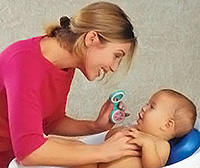 For careful skin treatment, all folds are recommended to use children's gels and wash foams. Soap is too dry skin, since even the pH of the children's soap differs significantly from the normal - the weakness of the child's skin reaction. Baby's head wash 1-2 times a week. Special gentle children's shampoos can be applied, not irritating eyes and do not have dried action on the skin. Upon completion of bathing, the infants are poured with water, the temperature of which is 1 degree with less water temperature in the bath. Then the skin of the child carefully «Drain» Towel or diaper. Skin folds are treated with baby oil, milk or lotion. In the summer months, with elevated sweating, it is better to use quickly absorbed baby cosmetics water-based. Folding in this case should be treated with talc, without oil use. Talc is first applied to hand, and then distributed over the body of a child. Directly on the skin of the baby talc can not be poured. His getting into the lungs is dangerous.
For careful skin treatment, all folds are recommended to use children's gels and wash foams. Soap is too dry skin, since even the pH of the children's soap differs significantly from the normal - the weakness of the child's skin reaction. Baby's head wash 1-2 times a week. Special gentle children's shampoos can be applied, not irritating eyes and do not have dried action on the skin. Upon completion of bathing, the infants are poured with water, the temperature of which is 1 degree with less water temperature in the bath. Then the skin of the child carefully «Drain» Towel or diaper. Skin folds are treated with baby oil, milk or lotion. In the summer months, with elevated sweating, it is better to use quickly absorbed baby cosmetics water-based. Folding in this case should be treated with talc, without oil use. Talc is first applied to hand, and then distributed over the body of a child. Directly on the skin of the baby talc can not be poured. His getting into the lungs is dangerous.
Itching during the tour well reduce cool water-soda compresses. 1 teaspoon of soda is added to the glass of boiled water. Then moistened and pressed cotton fabric or gauze applied to the skin in places of rash.
In addition to water compresses, warm baths (water temperature not higher than + 37.0-37.5 are applied with a strong itch° C) With the addition of thin grinding oatmeal or soda. With massive rash and pronounced itching, a pediatrician or a children's dermatologist can designate antiallergic (antihistamine) drugs, special medicinal creams or lotions containing zinc, aloe, chamomile and contributing to the decrease in itching and feeling heat. In addition, antiseptic (preventing infection penetration) of powders or binds, such as a weak solution of potassium permanganate, is often used.
No matter how attractive the idea of sea or river bathing in the summer heat, it should be refused: Battle of babies up to a year in open reservoirs is not recommended. Bathing outdoors summer sometimes most pediatricians are allowed from the six-month old baby. For such a water procedure, use a children's bath or an inflatable pool. Moreover, it is desirable with the help of hardening procedures (air baths, pouring cooler water after swimming) during the first half of life to prepare a child to such a procedure. The basic principles of the hardening technique should be graduality and moderation. Swimming in the fresh air is allowed in a windless, warm weather. Finding the baby under the right sunlight is unacceptable. It must be borne in mind that on the street external factors contribute to the faster cooling of the baby and the cooler of water in the bath and the pool. Therefore, such swims should not be long (up to 6-8 minutes), in the bathing should be pouring a warm water portion, maintaining the temperature at + 36-37° C. The most important thing - bathing should be the source of only positive emotions and in no way the cause of child crying and screaming.
Air baths. Good effect give air baths, contributing to the best evaporation of moisture from the skin of the infant. Experienced pediatricians are often recommended when «give the skin to breathe», Freeing her from clothes, while the drafts and direct exposure to sunlight on the delicate skin of the child should be avoided. Instead of sunscreen creams, it is better to use children's lotions with a high coefficient of protection against ultraviolet (at least 25-30 units). Air baths are also included in the category of hardening procedures. They can be carried out in the apartment or in the fresh air depending on the season and weather conditions. Kids up to three months should take air baths in a warm ventilated room. Crow older can be taken out to open air, but only in warmth (not lower than + 23-24° C), windless weather. Taking air baths do not follow right sunlight. Starting should be laid out the baby's shine for 1-2 minutes, for example, on the stomach before each feeding. By six months, the duration of air baths can be increased to 15-20 minutes a day, over 6 months - until half an hour.
Wake up. After each urination or defecation of the child (especially suffering from the Padel), it should be sealed under the jet of running water or handle the skin with wet children's napkins. Girls are isolated in one direction - in front of the back, in order to avoid driving infections into sex and urinary paths, diligently washing all the folds. Boys carefully wash the genitals, femoral and intersenned folds. After that, inguinal, femoral and interconnected folds are treated with children's cosmetic oil. The child should not be in wet clothes for a long time. Disposable diapers need to be changed at least 5-6 times a day and necessarily - after each stool..
Baby clothes. By the imperfection of thermoregulation processes in the children of the first year of life, it is necessary to monitor the air temperature in the room where the baby is located, was about + 20-22 degrees. Define «Outfit» crumbs in which he will feel comfortable, will help the rule «Plus one layer»: Look, we are dressed on you and dine baby like, adding one extra layer of clothing. It is desirable that the child's clothing will be made of natural materials. In any case, a cotton should fit to the infant. «Honor» Synthetic clothing promotes the development of the Pader.
When delivering a child of the first year of life, experts advise adhere to the following scheme:
at +23°C - 1-layer clothing (x / b underwear);
at + 21-23°C - 1-2-layer clothing (thin x / b underwear, light x / b Suit and x / b socks);
at + 18-20°C - 2-layer clothing (x / b underwear, dense suit (flannel or knitwear) and thin woolen socks);
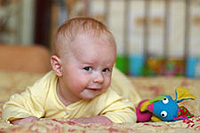 at + 15-17°C - 3-layer clothing (x / b linen, lightweight x / b Suit, half-wool or woolen suit with long sleeves and woolen socks).
at + 15-17°C - 3-layer clothing (x / b linen, lightweight x / b Suit, half-wool or woolen suit with long sleeves and woolen socks).
at +25°C and higher - thin X / B underwear;
at + 23-24°C - 1-2-layer clothing (thin x / b underwear, light x / b Suit and x / b socks);
at + 20-22°C - 2-layer clothing (x / b underwear, dense suit (flannel or knitwear) and thin woolen socks);
at + 17-19°C - 3-layer clothing (x / b underwear, lightweight x / b Suit, half-wool or woolen suit with long sleeves and woolen socks);
at + 14-16°C - 4-layer clothing (add to 3-layer clothes a warm blouse and a dense knitted hat);.
at + 10-13°C - 4-layer clothing (x / b underwear, x / b Suit, half-wing or dense knitted suit with long sleeves, x / b + woolen socks, autumn overalls, dense knitted or half-walled hat);
at + 3-6°C - 5-layer clothing (x / b linen, x / b costume, half-wool or woolen suit with long sleeves, warm sweatshirt, coat, 2 pairs of wool socks, autumn overalls, x / w cap, woolen hat, mittens and scarf).
To determine whether the baby is comfortable at this ambient temperature in several ways. For example, the back of the brush touch the spout of your chad. If the nose is warm, then it is warm and cozy, if the spout is hot, most likely, the baby is hot and you need to remove one layer of clothes from it. If the baby swept, it can even increase the temperature due to the imperfection of the thermoregulation system of its body. Home tend to the baby, let's drink. Well, if the tiny spout is cold, it means that the child is frozen. In such cases, babies often develop. In addition, you can touch the forearm, tibia or the baby's back. But the brushes of hands in crumbs can be cool and in conditions of temperature comfort.
Sharp marigold. When traveler, temperature discomfort (if, for example, a hot child), a baby can be restless, crying, capricious. In addition, the rash when the traveler itself is often accompanied by itching. Baby's marigolds are very sharp. Through combs on the background of the peel in the skin and the depths of the lying fabrics can penetrate infection. Therefore, in addition to timely cutting the nails, it is better to temporarily put the child suffering from the Potnik, on the handles special infant cotton mittens.
Trees are treated enough easily and with the recommendations performed quite quickly. However, when attaching infection and the general deterioration of the child's condition, it may be necessary to assign antibacterial drugs that the doctor discharges. Therefore, it is better to regularly carry out hygienic procedures, especially in hot summer days and rationally dress a child, which will help prevent the appearance of the Padern.

